The Children’s Home Sets Kids Up For Success With Theatre
Last week my mom and I had such a treat. We were invited to The Children’s Home Lower School theatre production of 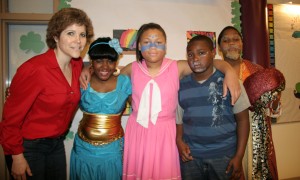 Aladdin. It was so special for us. This wasn’t just any theatre production at any school, this was a way The Children’s Home has found to get kids who learn differently or who traditionally have struggled in the classroom to be excited about learning…in essence, setting these young people with so much potential up for success.
Aladdin. It was so special for us. This wasn’t just any theatre production at any school, this was a way The Children’s Home has found to get kids who learn differently or who traditionally have struggled in the classroom to be excited about learning…in essence, setting these young people with so much potential up for success.
Below is a write-up I found on The Children’s Home website following the performance.
Over 30 students participated in the Lower School Theatre Program’s production of Aladdin for an audience of classmates, staff, board members and donors. The Lower School serves children in grades K-8 who have behavioral or learning challenges that have prevented them from succeeding in a traditional classroom. Many of them have experienced abuse and neglect or other factors that have inhibited their healthy development.
Last year, one student in particular had a very small role in the school play and he struggled to maintain his behavior and manage his emotions.
This year, he told Director Sharon Walterman that he wanted a bigger role “I told him that we needed to be able to count on him to maintain good behavior, because kids who take on bigger roles are harder to replace if they slip up and lose the privilege of participating in the play,” says Walterman. “He looked me in the eye and said, ‘You can count on me this year. This is what I want to do,’ and he’s done an amazing job,” says Walterman. He’s back on track and the theatre program is helping.
The Lower School started the therapeutic theatre program in 2006 to enhance student’s social skills, self-esteem, and 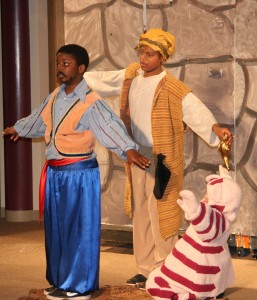 appreciation of the arts. Students are involved in many aspects of the play, including learning to use the spotlight and helping with set design and painting. Several students also act as the stage crew, and their classmates rely on them to set up props and move the set around as needed during the performance. The Children’s Home is well equipped to help students learn to manage their behavior, and the Theatre program offers the perfect opportunity to practice. Children learn and develop their social skills, like how to accept feedback from the Director. Learning to accept feedback is one of the key pieces of the Teaching Family Model, the evidence-based behavior modification practice that has been implemented campus-wide at The Children’s Home.
appreciation of the arts. Students are involved in many aspects of the play, including learning to use the spotlight and helping with set design and painting. Several students also act as the stage crew, and their classmates rely on them to set up props and move the set around as needed during the performance. The Children’s Home is well equipped to help students learn to manage their behavior, and the Theatre program offers the perfect opportunity to practice. Children learn and develop their social skills, like how to accept feedback from the Director. Learning to accept feedback is one of the key pieces of the Teaching Family Model, the evidence-based behavior modification practice that has been implemented campus-wide at The Children’s Home.
Should Pet Birds Be Allowed On Shoulders?
NOTE: I have a new pet behavior blog located at http://www.SoMuchPETential.com/blog. Thanks!
I’d like to address a question that is often asked by those who have birds.
Should birds be allowed on shoulders?
Well, let’s first ask – is there really such a thing as height dominance?
Steve Martin, renowned trainer and president of Orlando-based Natural Encounters, wrote about it in a paper actually. “To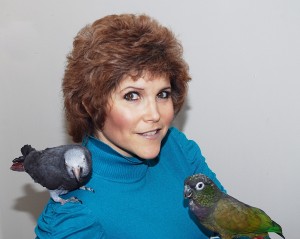 put it bluntly,” he said, “height dominance does not exist in parrots.”
put it bluntly,” he said, “height dominance does not exist in parrots.”
Talking to those in the know – ornithologists, field biologists, and wild bird behaviorists – there is no such thing as an alpha parrot. Aggression between wild parrots is brief, and a parrot that loses in one confrontation may very well win in the next.
A frustrated bird owner may question that. “Well, of course my bird gets dominant when he’s up high. He bites me every time I try to pick him up from somewhere high,” that person may say.
My response to that? Let’s do a little behavior analysis and look at a scenario that bird owners frequently use as an example of their pet showing ‘dominance’. Butch – a macaw – is on top of his cage playing with a toy when his owner, Suzy, needs to put him into his cage. She reaches for him and when he steps up, ‘without any warning’ (as is often described) he nails her.
Let’s look at some potential things that could be coming into play here.
• Birds are more comfortable stepping up. However since Butch is up high, unless Suzy gets on a chair, more than likely he is needing to step down to her and may even catch his long tail on the cage. Not very fun for Butch.
• Butch was perfectly happy playing with his toys. His past experience of stepping up for Suzy when he’s playing with his toys is that the consequence of his stepping up means he goes into his cage more often than not. And being inside that cage is just not as fun as being on top of it. (He’s at least taken away from doing something that he was enjoying doing.)
• Before Butch actually bit Suzy, he tried to show her he didn’t want to step up by pinning his eyes or other body language but she ignored or didn’t pay attention to it. Therefore biting her is the only behavior he can do to get the message across that he really does not want to step up at this time.
So, now, is this really a case of height dominance or is the bird simply behaving to escape something negative from the bird’s point of view?
Now back to the original question. Is it okay to wear your bird on your shoulder?
Well, there are a number of factors to take into consideration with regard to that decision. None of them have to do with height dominance.
• What is your relationship with your bird? Does your bird reliably ‘step up’ onto your hand?
• One problem with having your bird on your shoulder is that you can’t see his body language. Therefore you can’t effectively allow your bird to communicate a fear or aggressive response, thus you may be setting both of you up for a possible bite.
• Another consideration is that, while it’s fun companionship to wear shoulder birds it’s healthy to offer a variety of enriching activities for your pet that encourage independent play, foraging, and more. Encouraging your bird to stay perched in one place for long periods of time limits the time he could be learning and playing in different ways.
Right now I only allow Barnaby on my shoulder. Dreyfuss is my hand bird. While both of my birds are fairly fluent in ‘step up’ (Barnaby much more so than Dreyfuss, although she’s getting better), Barnaby has a much more predictable calm behavior than Dreyfuss. It’s not so important for me to keep an eye on Barnaby’s body language. However, Dreyfuss can be a little on the unpredictable side. It’s very important for me to watch her body language as I have her ‘step up’, therefore it is not a good idea for her to perch on my shoulder.
I do want to just mention that if it is a goal of yours to wear your parrot on your shoulder, a good first goal would be to teach a reliable ‘step up’ behavior.
YMCA Celebrates 40 Examples Of Character Values
I’d like to introduce you to pretty awe-inspiring youth who I’m very lucky to be getting to know. They are some of our Greater Cincinnati area’s great role models for caring, respect, honest, responsibility and caring. I’m talking about the 40 teenagers who will be celebrated on April 17 as YMCA of Greater Cincinnati Character Award recipients.
Take for example…
Linnea Head, a  student at Seven Hills School, whose influence has been described as ‘legendary’. A fearless model of ethics, it was during a school assembly when she stood before her student body and inspired every student to choose ‘trust’. Again she rallied her classmates to a cause when she heard about a Ugandan elementary school for displaced children.
student at Seven Hills School, whose influence has been described as ‘legendary’. A fearless model of ethics, it was during a school assembly when she stood before her student body and inspired every student to choose ‘trust’. Again she rallied her classmates to a cause when she heard about a Ugandan elementary school for displaced children.
Or
Dion’te Riley, a Withrow University High School student who traveled to the Domincan Republic to participate in a food drive. He personally collected enough food to fill 17 grocery carts for  families in need.
families in need.
Each one of the YMCA Character Award recipients has his/her own very personal story for impacting their world. I encourage you to please click the link and read more about them. If you know one of them…please congratulate them.
Or better yet…please join Tracey Johnson of FOX19 and the YMCA of Greater Cincinnati at the YMCA Character Awards Event on April 17. It begins at 6 p.m. at the School for Creative and Performing Arts. Cost is $25 per person for adults; $10 for youth. You can call 513-246-3205 to reserve a seat.
2012 YMCA Character Award recipients 2012
YMCA Character Award recipient list 2012
WIN TICKETS!
I will have two pairs of tickets to the event to give-a-way. I will be randomly
drawing two names of people who are Good Things Pledge champions. An additional
chance will be given for participating in the Good Things Going Around Facebook page.
Drawing will be on Wednesday night, April 11, 2012.
Not a Good Things Pledge champion yet? Just add your contact information on the Pledge page!
Honoree Shamari Hinkston Talks About ‘Caring’
Nature’s Amazing Wonders
Solving Problem Parrot Chewing With Enrichment
NOTE: I have a new pet behavior blog located at http://www.SoMuchPETential.com/blog. Thanks!
(a Hyde Park Living column written a number of years ago when my dear Chester was still with us)
In the days before Barnaby joined our flock, there was just Chester, Dreyfuss and me living together in a large two bedroom apartment. It actually was a wonderful place with many of the rooms being larger than those in my house and the large sliding glass window in the dining room made for a scenic view of the woods in the back. Pink floor length curtains hung from its side with a hand made valence (made by me) stretching across the top.
Chester and Dreyfuss stayed in the dining room, their cages arranged on a wall at either end of the table.
It made for some interesting meetings (I work from my home) and dinners with the family. Whoever thought only dogs begged for food has certainly never met my guys!
That was long before I had ever heard of behavioral analysis, and creating an enriching environment, well, that meant putting some acrylic toys in their cages, right??? I got them at the pet store, and they were labeled ‘bird toys’ after all.
I did a lot of things differently back then, and, as a result, so did the guys. Take for example those flowing, opaque pink curtains that were no longer transparent to the sun’s afternoon rays by the time I bought a house. If you’re ever looking for an awesome playgym for your parrot, I’ve got a suggestion. To Chester, they were the greatest thing next to safflower seeds. He’d slide down his cage stand, waddle across the floor and climb to his heart’s content. Up, down, right, left. If he was on the outer edge, he could swing it around so that only his head would stick out. And, if I didn’t find him while he was playing monkey on the curtains, he’d make it all the way up to the valence. I can’t tell you how many times I’d walk out to find him hanging upside down. When he’d see me, he’d tilt his head up as if to say ‘look mom, look at me!’
I was so frustrated because I couldn’t stop him, but at the same time, if you’ve ever seen an Alexandrine hanging upside down with such a comical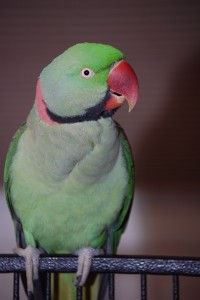 look about him, you can’t help but laugh. It’s just so funny.
look about him, you can’t help but laugh. It’s just so funny.
Then there was the time when I was on the telephone in a back bedroom and suddenly I heard C*R*U*N*C*H. That was the sound of a dining room chair being disassembled by a beak that didn’t have anything better to chew on. <sigh>
Needless to say, I was determined when we moved, that history was NOT going to repeat itself. And thankfully now, I have the knowledge to prevent it. (at least so far – and it’s been nine years)
It’s easy to look back on the situation now and see how Chester’s environment wasn’t setting him up for success, at least success through my eyes.
With a behavioral analysis hat on, let’s look at his curtain climbing antics.
Background: Chester is activity and Lisa deprived.
Antecedent: curtains were in view
Behavior: Chester waddled over and climbed the curtains
Consequence: sensory feedback – stimulation from his having to use his beak and feet activity – he was busy and engage; social – if I came out, he’d get my attention
Probable Future Behavior: When Chester is activity and Lisa deprived, he’ll continue to climb the curtains
So, what have I done differently to set him up for success?
Well, honestly, I really just needed to do some antecedent changes to prevent him from destroying things here and it has solved our problem. I have created a much more enriching environment. I even keep their cage doors open while I’m working in my basement and the only reason Chester will come off his cage is if something scares him. But I’m prepared for that too.
Chester, and all of my birds, have a lot to do during the day to keep them busy. I spend hours each week making strands of knotted hemp and beads that I hang all over the inside and outside of their cages. I wrap almonds in cloth or a box or paper cup for Chester and Dreyfuss. I have portions of a phone book wrapped in string on the cage floor of Chester’s cage and hanging toys for Barnaby, my Timneh Grey, to hang from.
The list goes on but you get the picture. They are busy if they want to be, and if they want to nap, that’s fine too.
But in the instance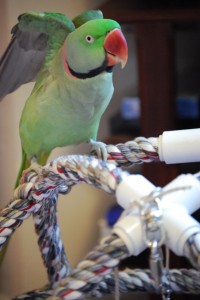 that Chester should come to the ground (and now I put him there too when I’m cleaning cages or watching tv), I’ve made some play stations for him. I got a mirrored toy from a human baby store and he can spend hours with it, so much so that I got a second one for the television room. (Scattering some beads or resting a tub of activity items next to it makes it even more reinforcing.) I bought a cheap plastic round snow sled and placed an Orbit play gym on top, tying strands of beads to it. This is also in the television room, next to the mirror toy. Chester receives such positive sensory and activity reinforcement for playing with these toys that there’s no reason for him to search out a dining room chair or curtain.
that Chester should come to the ground (and now I put him there too when I’m cleaning cages or watching tv), I’ve made some play stations for him. I got a mirrored toy from a human baby store and he can spend hours with it, so much so that I got a second one for the television room. (Scattering some beads or resting a tub of activity items next to it makes it even more reinforcing.) I bought a cheap plastic round snow sled and placed an Orbit play gym on top, tying strands of beads to it. This is also in the television room, next to the mirror toy. Chester receives such positive sensory and activity reinforcement for playing with these toys that there’s no reason for him to search out a dining room chair or curtain.
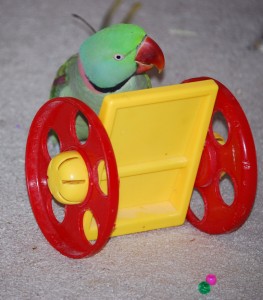 And I’d much rather laugh at him rolling his mirror toy around than hanging from my hand made valence any day!
And I’d much rather laugh at him rolling his mirror toy around than hanging from my hand made valence any day!































































